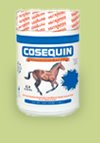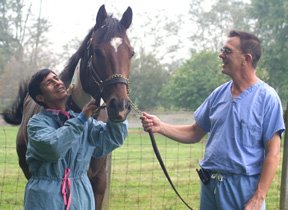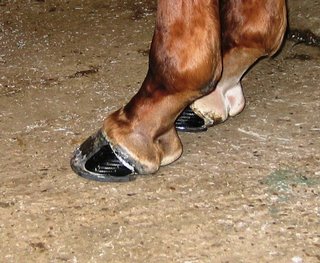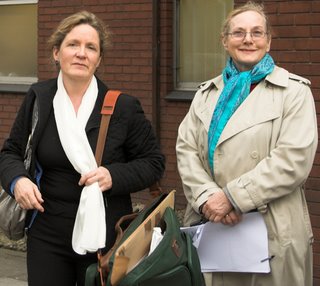 |
| There's a nice sign to welcome you to Saraoga, but there isn't one that says good-bye as you leave town. Perhaps that's because no one ever really leaves. Even if they don't come back the next summer they plan to, someday. |
From the small print in
The Saratoga Special recently: "We're in good shape, for the shape we're in." That's a quote attributed to David Mullins, Thoroughbred breeder and yearling consignor. I'll have to remember that one.
From famed sportswriter Red Smith: “To get to Saratoga from New York City, you travel about 150 miles north, turn onto Union Avenue and travel back in time to the mid-19th century. Its elegance and charm is why Saratoga has been selected as among the top 10 sports venues of the 20th century.”
From Dogwood Stable's Cot Campbell: “Louisville is fine; Lexington is OK; Miami is good; but Saratoga is truly glamorous. Saratoga is in a class by itself.”
The "Hoofcare@Saratoga" tour is playing like a tv-reality show so far. In other words, nothing is going according to the script! We've had one event cancelled because of 100 degree heat (even the racetrack was shut down, it was so hot)...and a cancelled speaker another week...a speeding ticket...a handicapped dog in the back seat...a car accident on the Mass Pike...and yet I know in another week or so when I am back in Massachusetts, those won't be the things I remember.
I'll remember the thrill of seeing people--dozens of people who've never heard of
Hoofcare & Lameness before that night--marching into Dr. Don Walsh's "Hoofcare@Saratoga" evening on laminitis. Yes, they really showed up, Hoofcare@Saratoga was a reality!
I'll remember driving down Nelson Avenue and peeking through the hedges for a glimpse of Stonerside, the former Greentree Stables training track and barns. If I was to pick my favorite horse architecture in the world, I think Stonerside/Greentree would be it. But Bill Mott moved to new quarters this year, and I think Godolphin Racing has taken over. Someone has...and they've put up big "No Trespassing" signs at the gates. How sad. I don't remember Stonerside ever being overrun with tourists.
I'll remember going to the farrier shop at the Skidmore Equestrian Center at midnight with Cornell farrier Michael Wildenstein and Skidmore farrier Jim Santore to see one of the sweetest horseshoeing shops in the land. I'll be back with a load of cameras one day to photograph Jim in this shop.
I'll remember a fabulous lunch way up in the turf club with racetrack legend Ada Gates, who was visiting from Los Angeles.
I'll remember watching Dianne Volz trying to do therapy on Flower Alley and wondering why she's not covered with bite marks (or worse).
I'll remember an August with almost perfect weather (once that horrific first week of stifling heat was over).
I'll remember the palpable emotion in the air at the dedication of the farriers' memorial behind the Oklahoma training track. And how surprised I was when Pat Day popped out of a golf cart and led everyone in prayer. He said that horseshoers had saved his life by keeping the horses safe. I'd not thought of it that way.
I'll remember the farmers' market in Saratoga and how nice it was to fill my car up with fresh vegetables for the long drive home.
I'll remember the easy-going attitude of everyone at the Parting and the bartenders' sincere attempts to try to understand just what laminitis is.
I'll remember the first time I entered the state park in Saratoga; I hadn't been there since I was in high school. All those trees. The architecture. The gardens. And the Gideon Putnam hotel, such a perfect place to stay. If only they allowed dogs.
I'll remember the school-girl thrill I got the first time I saw Funny Cide and Showing Up, just lounging in their stalls in Barclay Tagg's meticulous shedrow.
I'll remember a stolen hour when I was able to browse through the horse books at the Lyrical Ballad bookstore on Phila Street, with Don and Diana Walsh. That has to be one of my favorite places on earth. What a treat.
I'll remember standing next to Bluegrass Cat and one of Pletcher's handlers saying softly, "Suave, suave" and hearing it echo'd by the other handlers to the four other stallions tapdancing on the pavement. It sounded more like a Tibetan prayer chant than a horseman's command. (And "suave" they did, once each was efficiently hosed down, rewrapped, and sent to his stall.)
I'll remember the horseshoers, especially the parade of them through Butch Colbert's farrier supply trailer every Wednesday morning. So many new friends.
I never did get to wander through the shops on Broadway...or eat at Hattie's Chicken Shack...and I still haven't been to Yaddo. I suppose if I'd done it all and seen it all, there would be no reason to come back and I want to be very sure I have plenty of reasons to return to Saratoga next August.
We have great memories of this year to carry around in our hearts like so many talismen against change. There is always that feeling that even though it has been there for 250 years, this place is just too good to be true. It can't possibly last...but I sure hope it does.











